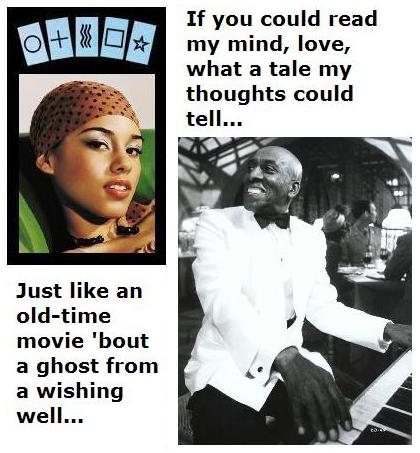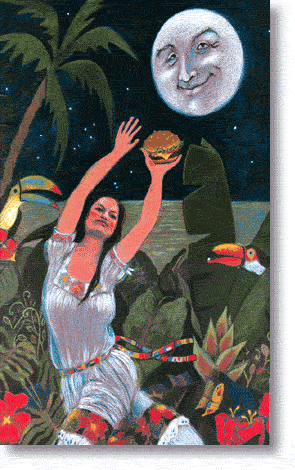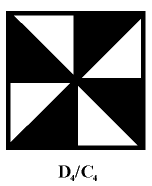Friday, August 23, 2019
Baseado
Thursday, August 13, 2015
Anniversary
Today is reportedly the anniversary of the death,
in Paris in 1822, of Jean Robert Argand.
Some related material …
"Wessel's fame as a mathematician rests solely
on this paper, which was published in 1799,
giving for the first time a geometrical interpretation
of complex numbers. Today we call this geometric
interpretation the Argand diagram but Wessel's
work came first. It was rediscovered by Argand
in 1806 and again by Gauss in 1831. ….
Of course it is not unreasonable to call the
geometrical interpretation of complex numbers
the Argand diagram since it was Argand's work
which was influential. It was so named before
the world of mathematics learnt of Wessel's prior
publication. In fact Wessel's paper was not
noticed by the mathematical community until 1895…."
See also Tilting at Whirligigs (Log24 on March 8, 2008)
and The Galois Quaternion.
Wednesday, June 24, 2015
Logos
The Santa Fe Institute logo, together with the previous post,
suggests a review of Whirligig and Quaternion for Goldstein.
Thursday, February 19, 2015
In the Place of the Skull
"I CAN TELL you about my friend Andrew,
the cognitive scientist. But it’s not pretty."
— Opening of Andrew's Brain: A Novel by
E. L. Doctorow, Random House, Jan. 14, 2014*
"…whirligig consciousness…."
—The New York Times Book Review
See also Inside the White Square (Log 24, Feb. 15, 2015):
 .
.
* Cf. Log24 on that date.
Monday, October 13, 2014
Raiders of the Lost Theorem
(Continued from Nov. 16, 2013.)
The 48 actions of GL(2,3) on a 3×3 array include the 8-element
quaternion group as a subgroup. This was illustrated in a Log24 post,
Hamilton’s Whirligig, of Jan. 5, 2006, and in a webpage whose
earliest version in the Internet Archive is from June 14, 2006.
One of these quaternion actions is pictured, without any reference
to quaternions, in a 2013 book by a Netherlands author whose
background in pure mathematics is apparently minimal:

In context (click to enlarge):
Update of later the same day —
Lee Sallows, Sept. 2011 foreword to Geometric Magic Squares —
“I first hit on the idea of a geometric magic square* in October 2001,**
and I sensed at once that I had penetrated some previously hidden portal
and was now standing on the threshold of a great adventure. It was going
to be like exploring Aladdin’s Cave. That there were treasures in the cave,
I was convinced, but how they were to be found was far from clear. The
concept of a geometric magic square is so simple that a child will grasp it
in a single glance. Ask a mathematician to create an actual specimen and
you may have a long wait before getting a response; such are the formidable
difficulties confronting the would-be constructor.”
* Defined by Sallows later in the book:
“Geometric or, less formally, geomagic is the term I use for
a magic square in which higher dimensional geometrical shapes
(or tiles or pieces ) may appear in the cells instead of numbers.”
** See some geometric matrices by Cullinane in a March 2001 webpage.
Earlier actual specimens — see Diamond Theory excerpts published in
February 1977 and a brief description of the original 1976 monograph:
“51 pp. on the symmetries & algebra of
matrices with geometric-figure entries.”
— Steven H. Cullinane, 1977 ad in
Notices of the American Mathematical Society
The recreational topic of “magic” squares is of little relevance
to my own interests— group actions on such matrices and the
matrices’ role as models of finite geometries.
Sunday, January 15, 2012
Saturday, January 7, 2012
Past Tense
From a post that was written for Twelfth Night—
Bernhard Weiss on the philosophy of Michael Dummett—
" … debates about realism, that is, those debates that ask
whether or not one or another aspect of the world is independent
of the way we represent that aspect to ourselves. For example,
is there a realm of mathematical entities that exists fully formed
independently of our mathematical activity? Are there facts about
the past that our use of the past tense aims to capture?"
Yes and Yes.
-
In memory of Anne Tyng, who died last year on Dec. 27,
see Number and Form. -
In memory of Frederica Sagor Maas, who
died on Twelfth Night, 2012, see Dogma. -
In memory of time I spent on Wilcox Avenue
in the Hollywood of the early sixties, see
Hans Reichenbach on the use of the past tense
(section 51 of Elements of Symbolic Logic ,
New York: The Macmillan Company, 1947, 287–98.)
See also The Whirligig of Time in this journal.
Wednesday, April 13, 2011
Monday, January 10, 2011
Big Time*
(True Grid continued)
"They're gonna put me in the movies,
They're gonna make a big star out of me…"

“Thus the whirligig of time brings in his revenges.”
Twelfth Night , Act V, Sc. I [text]
See also this journal on Twelfth Night, 2011.
* Background:
The Changewar stories of Fritz Leiber, including Big Time and "Damnation Morning."
The Shakespearean fool of Dec. 30 is also not without relevance.
Wednesday, May 28, 2008
Wednesday May 28, 2008
Mockingbird
|
CelebritySexNews.com
on Kylie Minogue:
From a web page on
you gotta ride it like you find it. Get your ticket at the station of the Rock Island Line.  in Rock Island, Illinois |
Related material:
Twenty-First Century Fox
(10/6/02)
Back to You, Kylie
(11/5/02)
Time, Eternity, and Grace
(11/22/02)
That Old Devil Moon
(1/1/03) and
The Shanghai Gesture
(1/3/03)
Whirligig
(1/5/03)
Harrowing
(4/19/03)
Temptation
(4/22/03)
Temptation
(4/9/04)
Tribute,
Train of Thought,
Drunk Bird, and
From Here to Eternity
(8/17/04-8/18/04)
Heaven and Earth
(9/2/04)
Habeas Corpus
(11/24/04)
X, continued
(12/4/04)
Birth and Death
(5/28/05)
Time Travel
(5/28/06)
Timeagain and
Two-Bar Hook
(8/9/06)
Echoes
(8/11/06)
Phantasmagoria
and Tequila!
(9/23/06)
Sunday, March 9, 2008
Saturday, March 8, 2008
Saturday March 8, 2008
Whirligigs

An answer:
“The whirligig of time”
— Shakespeare, Twelfth Night
and
Hamilton’s Whirligigs
Related material:
Rotation in the complex plane.
The plane was discovered
in the late 1700’s by Wessel:
|
Caspar Wessel
by J.J. O’Connor “Wessel’s paper [in Danish] was not noticed by the mathematical community until 1895… A French translation… was published in 1897 but an English translation of this most remarkable work was not published until 1999 (exactly 200 years after it was first published)…. We have called Wessel’s work remarkable, and indeed although the credit has gone to Argand, many historians of mathematics feel that Wessel’s contribution was [1]:-
In the [1] article the approaches by Argand and Wessel are compared and contrasted. Of course Wessel was a surveyor and his paper was motivated by his surveying and cartography work:-
However more is claimed for Wessel’s single mathematical paper than the first geometric interpretation of complex numbers. In [3] Crowe credits Wessel with being the first person to add vectors. Again this shows the depth of Wessel’s thinking but again, as the paper was unnoticed it had no influence on mathematical development despite appearing in the Memoirs of the Royal Danish Academy which by any standard was a major source of publications…. 1. … Biography in Dictionary of Scientific Biography (New York 1970-1990). 3. M.J. Crowe, A History of Vector Analysis (Notre Dame, 1967).” |
Wednesday, February 20, 2008
Wednesday February 20, 2008
|
M. V. Ramana on a famous quotation–
"Oppenheimer had learned Sanskrit at Berkeley so as to read the Gita in the original; he always kept a worn pink copy on the bookshelf closest to his desk. It is therefore likely that he may have actually thought of the original, Sanskrit, verse rather than the English translation. The closest that fits this meaning is in the 32nd verse from the 11th chapter of the Gita.
This literally means: I am kAla, the great destroyer of Worlds. What is intriguing about this verse, then, is the interpretation of kAla by Jungk and others to mean death. While death is technically one of the meanings of kAla, a more common one is time." "KAla" (in the Harvard-Kyoto transliteration scheme) is more familiar to the West in the related form of Kali, a goddess sometimes depicted as a dancing girl; Kali is related to kAla, time, according to one website, as "the force which governs and stops time." See also the novel The Fermata, by Nicholson Baker. The fact that Oppenheimer thought of Chapter 11, verse 32, of the Gita may, as a mnemonic device, be associated with the use of the number 1132 in Finnegans Wake.
|
The custom-made asterisk
above may be regarded
as a version of
the "Spider" symbol
of Fritz Leiber.
… Todo lo sé por el lucero puro
que brilla en la diadema de la Muerte.
Related material:
The previous five entries
and the entries of
this date three years ago.
Time of this entry:
Monday, February 11, 2008
Monday February 11, 2008
“A shape of some kind
for something that
has no shape.”
— Roy Scheider
in “2010”
For further details,
click on the monolith.
See also the Keystone State’s
lottery numbers for Sunday–
Grammy night and the
date of Scheider’s death:

These numbers suggest
the following links.
For further details related
to death and religion, see
a version of the cheer
“1234, who are we for?”
For further details related
to Grammy night, see
6/17, 2007:
A selection from the
Stephen King Hymnal

“… it’s going to be
accomplished in steps,
this establishment
of the Talented in
the scheme of things.”
— Anne McCaffrey,
Radcliffe ’47,
To Ride Pegasus
Monday, December 24, 2007
Monday December 24, 2007
From Saturday's entry
(Log24, Dec. 22, 2007)
a link goes to–
The five entries of June 14, 2007.
From there, the link
"One Two Three Four,
Who Are We For?"
goes to–
Princeton: A Whirligig Tour
(Log24, June 5, 2007).
From there, the link
"Taking Christ to Studio 60"
goes to–
The five Log 24 entries
prior to midnight Sept. 18, 2006.
From there, the link
"Log24, January 18, 2004"
goes to–
A Living Church.
From there, the link
"click here"
goes to–
In the Bleak Midwinter
(Internet Movie Database)…
Tagline:
The drama. The passion. The intrigue… And the rehearsals haven't even started.
Plot Summary:
Out of work actor Joe volunteers to help try and save his sister's local church
for the community by putting on a Christmas production of Hamlet…
"… were it not that
I have bad dreams."
— Hamlet
Related material:
The New York Times online
obituaries of December 22,
Ike Turner's
"Bad Dreams" album
(see Log24, July 12, 2004),
"Devil Music," a composition
by H. S. M. Coxeter,
and
Those desiring more literary depth
may consult the G. K. Chesterton
play "Magic" for which Coxeter
wrote his "Devil Music" and
the Ingmar Bergman film
"The Magician" said to have
been inspired by Chesterton.
Thursday, July 12, 2007
Thursday July 12, 2007
kind of a hat
on the universe,
a lid that kept
everything underneath it
where it belonged.”
— Carrie Fisher,
Postcards from the Edge


5/11:
“Going Up.”
— “Love at the
Five and Dime,”
by
Nanci Griffith
234:
Thursday, June 14, 2007
Thursday June 14, 2007
"Kurt Waldheim, the former United Nations Secretary General and President of Austria whose hidden ties to Nazi organizations and war crimes was [sic] exposed late in his career, died today at his home in Vienna. He was 88." —The New York Times this afternoon
From a story by
Leonard Michaels
linked to on
Aaron Sorkin's
birthday, June 9:
It has been said that the unexamined life isn't worth living. Nachman wasn't against examining his life, but then what was a life? ….
Internet user signed
"George Polya"–
"Steven Cullinane is a Liar."
3. L'Affaire Dharwadker continues
(May 31, 2007)

Thursday, June 7, 2007
Thursday June 7, 2007
From the May 6, 2007,
New York Times,
Charles McGrath on
Philip K. Dick:
His early novels, written in two weeks or less, were published in double-decker Ace paperbacks that included two books in one, with a lurid cover for each. "If the Holy Bible was printed as an Ace Double," an editor once remarked, "it would be cut down to two 20,000-word halves with the Old Testament retitled as 'Master of Chaos' and the New Testament as 'The Thing With Three Souls.'"
Click to enlarge.
As for "the thing with
three souls"–
Part I:
"Educate, Empower, Entertain"
— Motto of Yolanda King
Part II:
Three universities
(but not those of
Martin Myerson)–
Princeton, Harvard, Cambridge
Tuesday, June 5, 2007
Tuesday June 5, 2007
A Whirligig Tour

Symbol from a
website on
“Presbyterian
Creedal Standards”
The above symbol
appeared here
on 11/8/02.
Related material:
1. The remarks of
Bradley Whitford
at Princeton’s
Class Day yesterday:

2. An illustration from
Log 24 on 11/10/06:
|
|
|
|
Paul Robeson in |
3. The Whirligig of Time
(1/5/03):

4. Natalie Angier, priestess of Scientism
(5/26/07), and her new book
The Canon: A Whirligig Tour of
the Beautiful Basics of Science
(available as a special from
Amazon.com):
| Better Together Buy this book with God Is Not Great: How Religion Poisons Everything by Christopher Hitchens today!
|
Wednesday, November 22, 2006
Wednesday November 22, 2006
“Who knows where madness lies?”
— Rhetorical question
in “Man of La Mancha”
(See previous entry.)
Using madness to
seek out madness, let us
consult today’s numbers…
Pennsylvania Lottery
Nov. 22, 2006:
Mid-day 487
Evening 814
The number 487 leads us to
page 487 in the
May 1977 PMLA,
“The Form of Carnival
in Under the Volcano“:
“The printing presses’ flywheel
marks the whirl of time*
that will split La Despedida….”
From Dana Grove,
A Rhetorical Analysis of
Under the Volcano,
page 92:
is revealed by the evening
lottery number, 814, which
leads to an entry of 8/14:

“… a point of common understanding
between the classic and romantic worlds.
Quality, the cleavage term between
hip and square, seemed to be it.”
— Robert M. Pirsig

Rebecca Goldstein
The 8/14 entry also deals with
Rebecca Goldstein, who
seems to understand
such cleavage
very well.
(See also today’s previous entry.)
* Cf. Shakespeare’s “whirligig of time“
linked to in the previous entry.)
Monday, October 9, 2006
Monday October 9, 2006
To Apollo

“This is the garden of Apollo,
the field of Reason….”
John Outram, architect
To Apollo (10/09/02)
Art Wars: Apollo and Dionysus (10/09/02)
Balanchine’s Birthday (01/09/03)
Art Theory for Yom Kippur (10/05/03)
A Form (05/22/04)
Ineluctable (05/27/04)
A Form, continued (06/05/04)
Parallelisms (06/06/04)
Ado (06/25/04)
Deep Game (06/26/04)
Gameplayers of Zen (06/27/04)
And So To Bed (06/29/04)
Translation Plane for Rosh Hashanah (09/15/04)
Derrida Dead (10/09/04)
The Nine (11/09/04)
From Tate to Plato (11/19/04)
Art History (05/11/05)
A Miniature Rosetta Stone (08/06/05)
High Concept (8/23/05)
High Concept, Continued (8/24/05)
Analogical Train of Thought (8/25/05)
Today’s Sermon: Magical Thinking (10/09/05)
Balance (10/31/05)
Matrix (11/01/05)
Seven is Heaven, Eight is a Gate (11/12/05)
Nine is a Vine (11/12/05)
Apollo and Christ (12/02/05)
Hamilton’s Whirligig (01/05/06)
Cross (01/06/06)
On Beauty (01/26/06)
Sunday Morning (01/29/06)
Centre (01/29/06)
New Haven (01/29/06)
Washington Ballet (02/05/06)
Catholic Schools Sermon (02/05/06)
The Logic of Apollo (02/05/06)
Game Boy (08/06/06)
Art Wars Continued: The Krauss Cross (09/13/06)
Art Wars Continued: Pandora’s Box (09/16/06)
The Pope in Plato’s Cave (09/16/06)
Today’s Birthdays (09/26/06)
Symbology 101 (09/26/06)
Thursday, January 5, 2006
Thursday January 5, 2006
Thursday January 5, 2006

For details, see Visualizing GL(2,p).
Saturday, July 16, 2005
Saturday July 16, 2005
|
Dance of |
Paul Newman as |
From "The Bomb of the Blue God," by M. V. Ramana—
Gita 11:32 —
kalosmi lokaksaya krt pravrddho
"This literally means: I am kala, the great destroyer of Worlds. What is intriguing about this verse, then, is the interpretation of kala by Jungk and others to mean death. While death is technically one of the meanings of kala, a more common one is time." ![]()
![]() See 1132 AD & Saint Brighid, and my 2003 weblog entries of January 5 (Twelfth Night and the whirligig of time), January 31 (St. Bridget's Eve), and February 1 (St. Bridget's Day).
See 1132 AD & Saint Brighid, and my 2003 weblog entries of January 5 (Twelfth Night and the whirligig of time), January 31 (St. Bridget's Eve), and February 1 (St. Bridget's Day).
The fact that Oppenheimer thought, on this date in 1945, of Chapter 11, verse 32, of the Gita may, as a mnemonic device, be associated with the use of the number 1132 in Finnegans Wake.
Related material for
Michael Flatley on his
July 16 birthday:

Michael and other Irish persons
may benefit from the film
"Indiana Jones and the Temple of Doom"
as an introduction to
the Dance of Shiva and Kali.
On a more personal level:
Log24 entries of July 12 and July 13.
Wednesday, January 5, 2005
Wednesday January 5, 2005
Death and the Spirit
A meditation for Twelfth Night
on "the whirligig of time"
- Frank Kelly Freas, who created, among other works, 400 portraits of saints for the Franciscans and the covers of Mad Magazine from 1958 through 1962. "I found it difficult to shift my artistic gears from the sublime to the ridiculous and back again," he said of his departure from Mad.
- Will Eisner, "an innovative comic-book artist who created the Spirit, a hero without superpowers, and the first modern graphic novel."
Yesterday's entry provided an approach to The Dark Lady, Kali, that was, in Freas's apt word, "ridiculous." The illustration below, "Mate," is an attempt to balance yesterday's entry with an approach that is, if not sublime, at least more serious. It is based on a similar illustration from Jan. 31, 2003, with actress Judy Davis playing The Dark Lady. Today it seems appropriate to replace Davis with another actress (anonymous here, though some may recognize her). I once knew her (unlike Davis) personally. One of my fondest memories of high school is reading Mad Magazine with her in the school lunch room. Our lives diverged after high school, but I could happily have spent my life in her company.
– S. H. Cullinane, Twelfth Night, 2005

A diamond and its dual "whirl" figure—
or a "jewel-box and its mate"
ending on Feb. 1, 2003, and the
perceptive remarks of Ryan Benedetti
on Sam Spade and Brigid O'Shaughnessy.
As for Eisner and "The Spirit,"
which has been called
"the quintessential noir detective series,"
those preferring non-graphic stories
may picture Spade or his creator,
Dashiell Hammett, in the title role.
Then, of course, there are Eisner's later
story, "A Contract With God,"
John 4:24, and 1916 4/24.
Monday, January 5, 2004
Monday January 5, 2004
Whirligig

“Thus the whirligig of time
brings in his revenges.”
Twelfth Night. Act v. Sc. 1.
Twelfth night is the night of January 5-6.
Tonight is twelfth night in Australia;
12:25 AM Jan. 5 in New York City is
4:25 PM Jan. 5 in Melbourne.
Monday, February 24, 2003
Monday February 24, 2003
Moulins Rouges
Today is the birthday of composer Michel Legrand (“The Windmills of Your Mind”) and of philologist Wilhelm Grimm (Grimms’ Fairy Tales).
|
|
|
|
See the following past entries:
October 6, 2002: “Twenty-first Century Fox”
November 7, 2002: “Endgame”
November 8, 2002: “Religious Symbolism at Princeton”
January 5, 2003: “Whirligig”
January 5, 2003: “Culinary Theology”
January 6, 2003: “Dead Poet in the City of Angels”
January 31, 2003: “Irish Fourplay”
February 1, 2003; “Time and Eternity”
February 5, 2003: “Release Date”
Tuesday, February 18, 2003
Sunday, January 5, 2003
Sunday January 5, 2003
Culinary Theology
A comment on "Whirligig," the previous entry:
|
When I hear 'red mill,' |
Red Mill |
| Posted 1/5/2003 at 5:10 am by HomerTheBrave. |
From my favorite theologian, Jimmy Buffett:
"Well good God Almighty,
which way do I steer for my
Chorus:
Cheeseburger in paradise (paradise)
Makin' the best of every virtue and vice (paradise)
Worth every damn bit of sacrifice (paradise)
To get a cheeseburger in paradise
To be a cheeseburger in paradise
I'm just a cheeseburger in paradise!"
For some, paradise — or at least the gateway to paradise — is at Puerto Vallarta, Mexico.
From a one-act version (p. xvi) of
"The Night of the Iguana":
"MISS JELKES: Is this the menu? (She has picked up a paper on the table.)
SHANNON: Yes, it's the finest piece of rhetoric since Lincoln's Gettysburg Address."
"Cheeseburger In Paradise, Puerto Vallarta, opened for business on November 7, 1999." — The same date, mentioned in last night's "Whirligig" entry, that Fox Studios Australia opened in Sydney with a song by Kylie Minogue.

Sunday January 5, 2003
Whirligig
Thus the whirligig of time brings in his revenges.
Twelfth Night. Act v. Sc. 1.
Twelfth night is the night of January 5-6.
Tonight is twelfth night in Australia; 4 AM Jan. 5
in New York City is 8 PM Jan. 5 in Sydney.
An October 6 entry:
Twenty-first Century Fox
On Sunday, October 6, 1889, the Moulin Rouge music hall opened in Paris, an event that to some extent foreshadowed the opening of Fox Studios Australia in Sydney on November 7, 1999. The Fox ceremonies included, notably, Kylie Minogue singing "Diamonds are a Girl's Best Friend."
|
Red Windmill
|
Kylie Minogue
|
For the mathematical properties of the red windmill (moulin rouge) figure at left, see Diamond Theory.
An October 5 entry:
The Message from Vega
|
|
|
"Mercilessly tasteful"
— Andrew Mueller,
review of Suzanne Vega's
"Songs in Red and Gray"
In accordance with the twelfth-night
"whirligig of time" theme,
here are two enigmatic quilt blocks:
|
Devil's Claws, or |
Yankee Puzzle, or |
December 16, 2002
what do they teach them at these schools?"


























